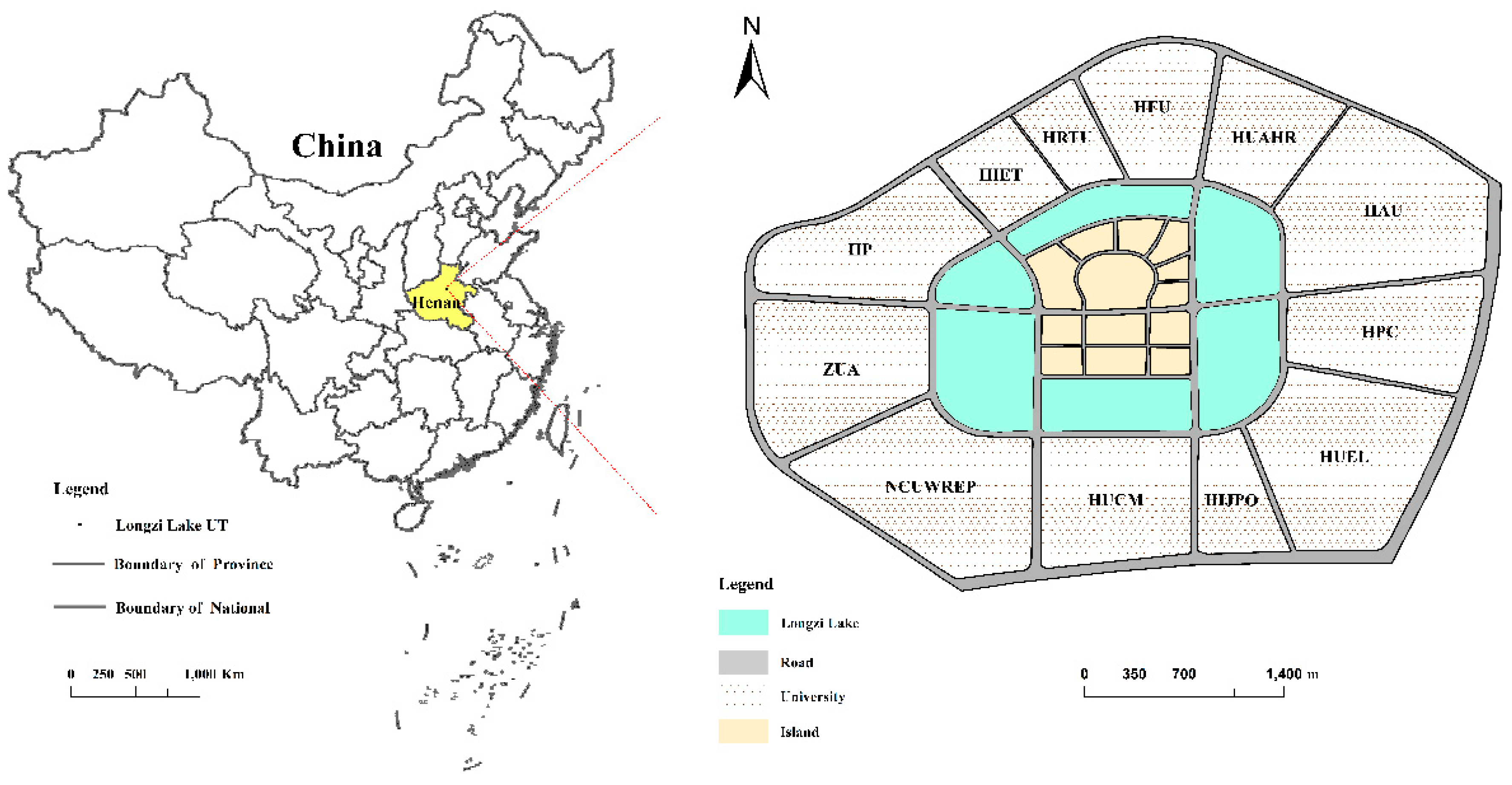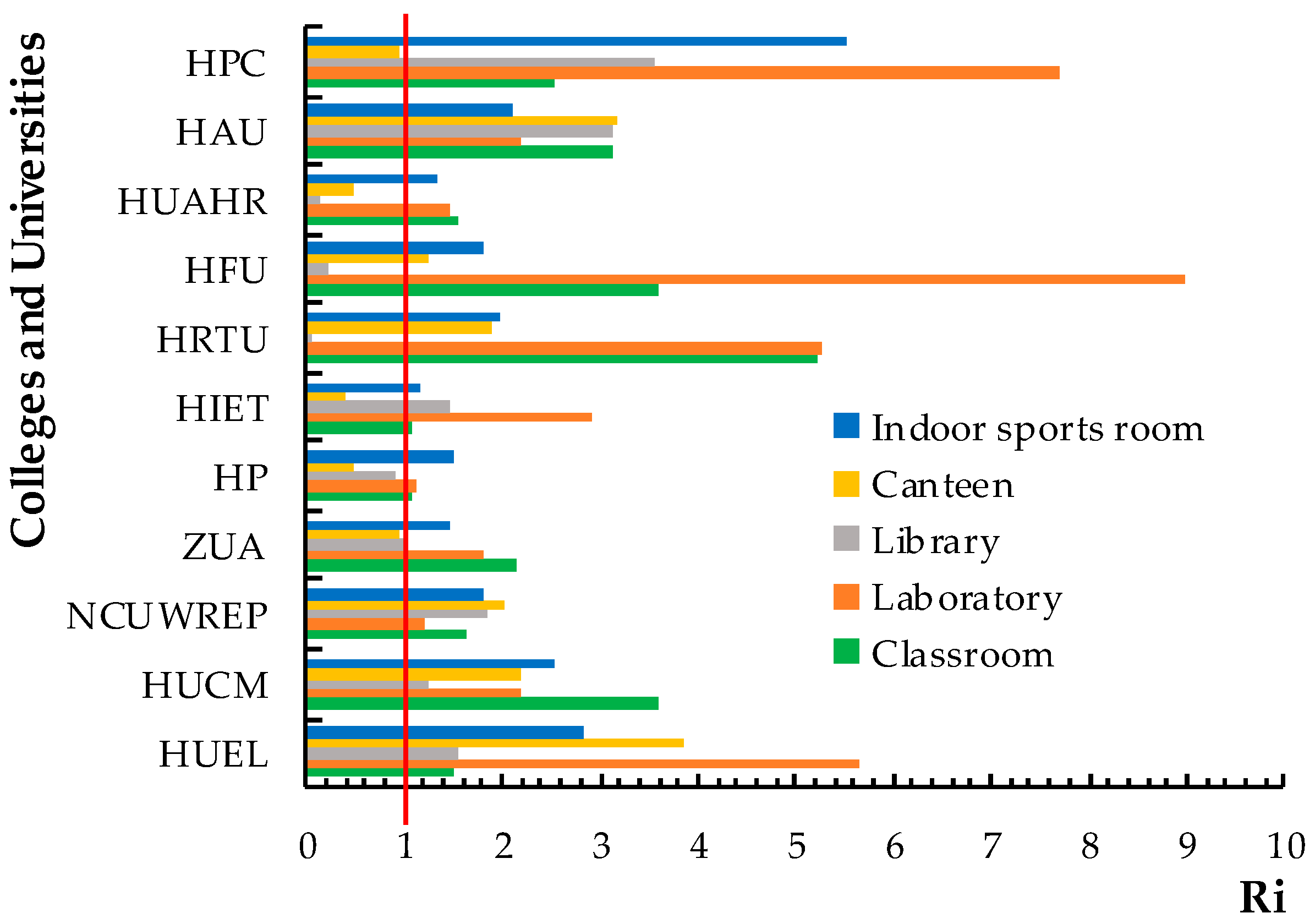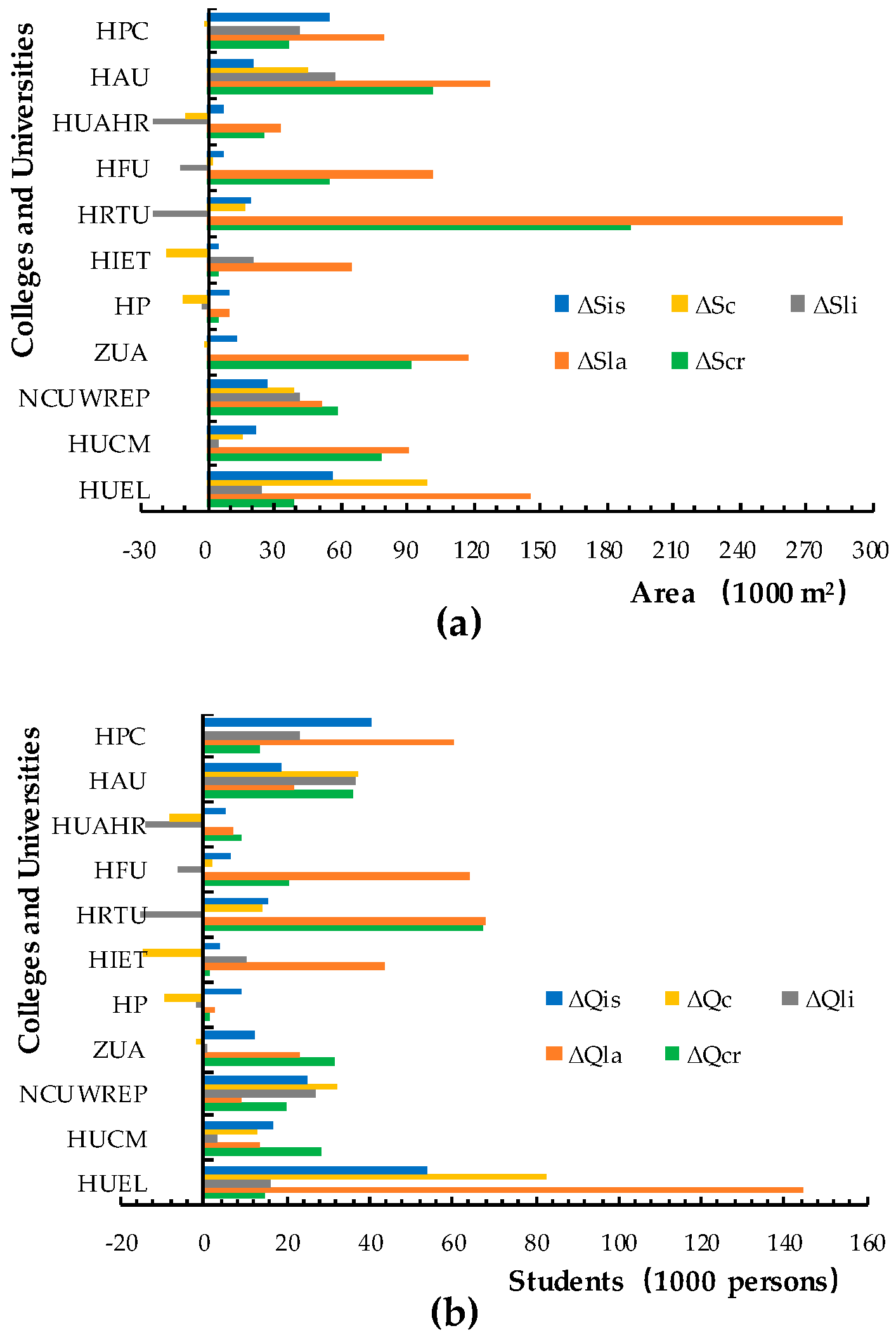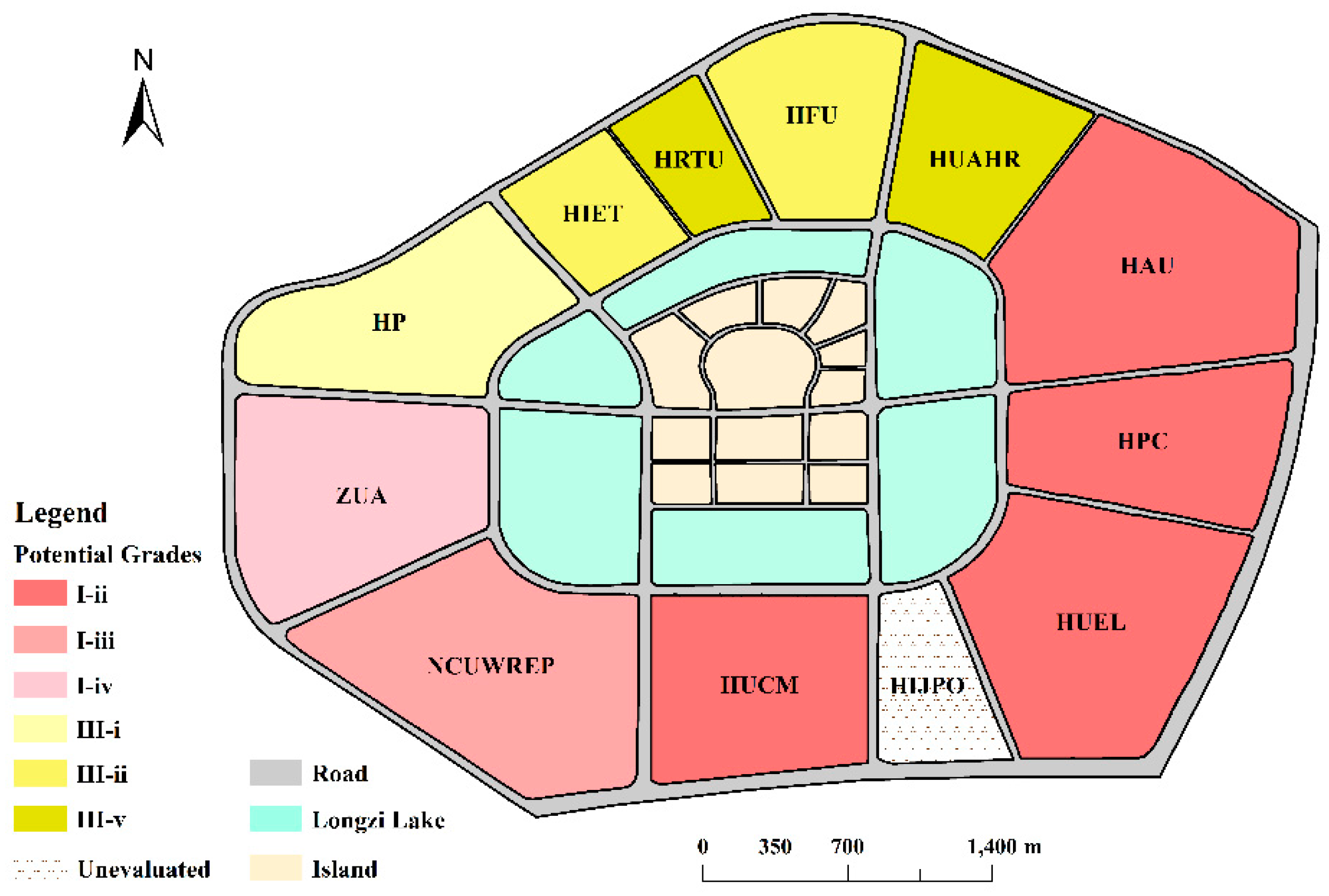Inter-Campus Sharable Potential of Hardware Educational Resources in A University Town: Connotation, Determination Method and A Case Study
Abstract
1. Introduction
2. Literature Review and Research Hypothesis
3. Connotation of ISPHERs in A UT
4. Methodology
4.1. Data Collection
4.2. HERs that Can Be Shared among Campuses
4.3. Calculation of ISPHERs
4.4. Calculation of the Potential Grade
5. Study Area and Data Source
5.1. Study Area
5.2. Data Source
6. Results
6.1. The Sharable HERs and Their Area Quota of Per Student in Longzi Lake UT
6.2. Surplus or Insufficient State of HERs’ for Each College and University
6.3. The ISPHERs in Longzi Lake UT
6.4. The Sharable Potential Index in Longzi Lake UT
7. Discussion
7.1. Characteristics of ISPHERs in Longzi Lake UT
7.2. Implications for Guarantee System
7.3. Recommendations for Future Study
8. Conclusions
Author Contributions
Funding
Conflicts of Interest
References
- Feichtinger, T.; Niedanfeichtinger, S. Assessing regional sustainable development through an integration of nonlinear principal component analysis and Gram Schmidt orthogonalization. Ecol. Indic. 2016, 63, 71–81. [Google Scholar] [CrossRef]
- Wariah, S.S.; Karthikeyan, K. Trends in higher education and growth in India: A case study. J. Phys. Confer. Ser. 2018, 1139, 012033. [Google Scholar] [CrossRef]
- Ou, D.; Hou, Y. Bigger pie, bigger slice? The impact of higher education expansion on educational opportunity in China. Res. High. Educ. 2019, 60, 358–391. [Google Scholar] [CrossRef]
- Zhao, L. Analysis of resource shareable based on university city mode. Course Educ. Res. 2015, 1, 1–11. [Google Scholar] [CrossRef]
- Shi, M.H.; Yao, W.X.; Liu, B. Discussion on the shareable of teaching resources in university city: A case study of Shanghai Songjiang university town. Text. Appar. Educ. 2014, 29, 233–235. [Google Scholar] [CrossRef]
- Pounds, A.; Bostock, J. Open educational resources (OER) in higher education courses in aquaculture and fisheries: Opportunities, barriers, and future perspectives. Aquacult. Int. 2019, 1, 695–710. [Google Scholar] [CrossRef]
- Kwak, S. How korean language arts teachers adopt and adapt open educational resources: A study of teachers’ and students’ perspectives. Int. Rev. Res. Open. Dis. 2017, 18, 193–211. [Google Scholar] [CrossRef][Green Version]
- Karen, H.Q.; Rhona, S.W.; Gail, K.; Harold, L.; Frank, C.W. University-partnered new school designs: Fertile ground for research–practice partnerships. Edu. Res. 2017, 46, 143–146. [Google Scholar]
- Marjorie, L.D.-W.; Christopher, S. Conducting comprehensive assessment within community colleges: Administrative, educational, and student support (AES) assessment with the shults Dorimé Williams taxonomy. New Dir. Commun. Coll. 2019, 186, 61–69. [Google Scholar] [CrossRef]
- Wey, W.M.; Hsu, J. New urbanism and smart growth: Toward achieving a smart national taipei university district. Habitat. Int. 2014, 42, 164–174. [Google Scholar] [CrossRef]
- Ye, C.; Chen, M.; Chen, R.; Guo, Z. Multi-scalar separations: Land use and production of space in Xianlin, a university town in Nanjing, China. Habitat Int. 2014, 42, 264–272. [Google Scholar] [CrossRef]
- Zhang, X.L.; Tang, A.G. Independence and share: Target of movement and channel about city town. Res. Educ. Dev. 2002, 5, 12–15. [Google Scholar] [CrossRef]
- Friedman, H.H.; Kass, F. How the city university of New York (CUNY) can improve efficiency, reduce waste, and save millions? Soc. Sci. Electron. Publ. 2018. [Google Scholar] [CrossRef]
- Lu, T.J.; Buehler, R.; Mondschein, A.; Hankey, S. Designing a bicycle and pedestrian traffic monitoring program to estimate annual average daily traffic in a small rural college town. Transp. Res. Part D Transp. Environ. 2017, 53, 193–204. [Google Scholar] [CrossRef]
- Kirby, W.C. The Chinese century? The challenges of higher education. Daedalus 2014, 143, 145–156. [Google Scholar] [CrossRef]
- Li, C.; Xu, Z. The study on the intensive use of land resources in the process of new urbanization. IOP Conf. Ser. Earth Environ. Sci. 2017, 100, 012169. [Google Scholar] [CrossRef]
- Yeo, I.A.; Dobson, K.; Josso, P.; Pearce, R.B.; Howarth, S.A.; Lusty, P.A.J. Assessment of the mineral resource potential of atlantic ferromanganese crusts based on their growth history, microstructure, and texture. Minerals 2018, 8, 327. [Google Scholar] [CrossRef]
- Aseres, S.A. Assessment of the potentials tourism resources of choke mountain and its environs, Ethiopia. J. Tour. Hosp. 2015, 4, 2. [Google Scholar] [CrossRef]
- Mugagga, F.; Nabaasa, B.B. The centrality of water resources to the realization of sustainable development goals (SDG). a review of potentials and constraints on the African continent. Int. Soil Water Conserv. Res. 2016, 4, 215–223. [Google Scholar] [CrossRef]
- Koohafkan, A.P. Land resources potential and sustainable land management: An overview. Nat. Resour. Forum 2010, 24, 69–81. [Google Scholar] [CrossRef]
- Marcus-Quinn, A. The potential of high-quality open educational resources (oers) for the teaching of english poetry. J. Poetry Ther. 2016, 29, 33–45. [Google Scholar] [CrossRef]
- Song, J. The digital way to develop the resources potential of migrant workers’ continuing education, based on the analysis of the current situation of migrant workers’ readers. Publ. Res. 2014, 12, 85–88. [Google Scholar] [CrossRef]
- Mutual Selection of Courses and Mutual Recognition of Credits of Five Universities in Henan. Available online: http://www.chinanews.com/sh/2019/01-09/8723721.shtml (accessed on 21 February 2020).
- Brockliss, L. Gown and town: The university and the city in Europe, 1200–2000. Minerva 2000, 38, 147–170. [Google Scholar] [CrossRef]
- Ngo, L.M.; Trinh, T.A. A university-city complex, a model for sustainable development: A case study in Vietnam. Procedia Eng. 2016, 142, 92–99. [Google Scholar] [CrossRef]
- Woldoff, R.A.; Weiss, K.G. Studentification and disorder in a college town. City Commun. 2018, 4. [Google Scholar] [CrossRef]
- Mayfield, L. Town and gown in America: Some historical and institutional issues of the engaged university. Educ. Health Chang. Learn. Pract. 2001, 14, 231–240. [Google Scholar] [CrossRef]
- Harris, M.S. The soft underbelly of universities as anchor institutions: The disconnect between university and community research priorities. High. Educ. Policy 2019, 2. [Google Scholar] [CrossRef]
- Brandt, C.; de Mortanges, C. City branding: A brand concept map analysis of a university town. Place Brand Publ. Dipl. 2011, 7, 50–63. [Google Scholar] [CrossRef]
- Moore, J.G. Mississippi College Towns: Assessing the Geography of Collegiate Culture. Master’s Theses, University Southern Mississippi, Hattiesburg, MS, USA, May 2016. [Google Scholar]
- Hooker, B.; Small, E.; Dizard, J.; Darlington, S.; Farnham, T.; Benkley, J. Five College Blue Sky Report. 2012. Available online: https://scholarworks.umass.edu/cgi/viewcontent.cgi?article=1002&context=csi (accessed on 21 February 2020).
- Li, Z.; Li, X.; Wang, L. Speculative urbanism and the making of university towns in China: A case of Guangzhou university town. Habitat Int. 2014, 44, 422–431. [Google Scholar] [CrossRef]
- Tlili, A.; Huang, R.; Chang, T.-W.; Nascimbeni, F.; Burgos, D. Open educational resources and practices in China: A systematic literature review. Sustainability 2019, 11, 4867. [Google Scholar] [CrossRef]
- Jing, L. Constructing resource sharing collaboration for quality public education in urban china: Case study of school alliance in beijing. Int. J. Educ. Dev. 2018, 59, 9–19. [Google Scholar] [CrossRef]
- Halachmi, A.; Ngok, K. Of sustainability and excellence: Chinese academia at a crossroads. Publ. Adm. Rev. 2009, 69, S13–S20. [Google Scholar] [CrossRef]
- Guan, M.H. Shareable university assets of university resource planning theory: A case study of Fuzhou university town. J. Minjiang Univ. 2016, 6, 114–120. [Google Scholar] [CrossRef]
- Li, Z.H. Research on the Cooperative development and shareable of foreign journal resources in higher education mega center: Taking fuzhou higher education mega center as an example. J. Acad. Libr. 2012, 6, 71–75. [Google Scholar] [CrossRef]
- Chen, P. Theoretical ideas and policy suggestions on college sports resource integration: A case study on Chongqing university town. J. Beijing Sport Univ. 2016, 39, 87–93. [Google Scholar]
- Zhang, X.M. Study on the influencing factors of the shareable of sports field resource in Chinese university City based on factor analysis. J. Guangzhou Sp. Univ. 2015, 2, 120–122. [Google Scholar] [CrossRef]
- Montgomery, C. Transnational partnerships in higher education in China: The diversity and complexity of elite strategic alliances. Lond. Rev. Educ. 2016, 14, 70–85. [Google Scholar] [CrossRef]
- Li, X.; Roberts, J.; Yan, Y.; Tan, H. Knowledge shareable in China–UK higher education alliances. Int. Bus. Rev. 2014, 23, 343–355. [Google Scholar] [CrossRef]
- Hu, D.; Luo, A.; Liu, H. Open access in China and its effect on academic libraries. J. Acad. Libr. 2013, 39, 110–112. [Google Scholar] [CrossRef]
- Nie, Z.M.; Liu, Z.Y. The reform of quality education resource shareable system: From bureaucracy to communalization. J. Chin. Soc. Educ. 2017, 5, 56–61. [Google Scholar]
- Ngok, K. Massification, bureaucratization and questing for “world-class” status: Higher education in China since the mid-1990s. Int. J. Educ. Manag. 2008, 22, 547–564. [Google Scholar] [CrossRef]
- Wu, J.; Yuan, Y.; Wang, Y.H.; Yang, Z.Z. Evaluation on the intensive use of higher education land with multiple perspectives: A case study of shandong province. China Land Sci. 2018, 32, 67–74. [Google Scholar] [CrossRef]
- The Land Administration Law of the People’s Republic of China. Available online: http://www.sohu.com/a/338926400_120209902 (accessed on 21 February 2020).
- Tan, S.K.; Zhou, M. Response of universities in Wuhan to the intensive land use policy. Resour. Sci. 2012, 34, 143–149. [Google Scholar]
- Ruoppila, S.; Zhao, F. The role of universities in developing China’s university towns: The case of Songjiang university town in Shanghai. Cities 2017, 69, 56–63. [Google Scholar] [CrossRef]
- Zhu, Q.; Jia, T.D.; Fei, M.; Wu, K.; Sun, X. Using a Delphi method and the analytic hierarchy process to evaluate Chinese search engines. Online Inf. Rev. 2013, 35, 942–956. [Google Scholar] [CrossRef]
- Longzi Lake University Town. Available online: https://baike.so.com/doc/5576982-5790671.html (accessed on 21 February 2020).
- Building Area Index of Ordinary Colleges and Universities (191–2018). Available online: https://wenku.baidu.com/view/aac3f66bdc36a32d7375a417866fb84ae45cc397.html (accessed on 21 February 2020).
- Premchand-Mohammed, S. Bridging the gap between print and electronic resources at a multi-campus university library. Vine 2011, 41, 315–333. [Google Scholar] [CrossRef]
- King, C.J. On the Apportionment of Administrative Governance Functions within Multi-Campus Universities and University Systems. Research & occasional paper series: Cshe.16.13; 2013. Available online: https://eric.ed.gov/?id=ED545189 (accessed on 21 February 2020).
- Nie, Z.; Zurlo, F.; Camussi, E.; Annovazzi, C. Service ecosystem design for improving the service sustainability: A case of career counselling services in the Italian higher education institution. Sustainability 2019, 11, 1427. [Google Scholar] [CrossRef]
- Lippincott, J.K. New library facilities: Opportunities for collaboration. Resour. Shareable Info. Netw. 2004, 17, 147–157. [Google Scholar] [CrossRef]
- Schwanz, K. Thinking about a joint-use library? Coll. Res. Libr. News 2019, 61, 478–482. [Google Scholar] [CrossRef]
- Wang, Y.B.; Hu, Y.L.; Mi, C.L.; Song, Q.Q.; Liu, J.H.; Jin, J. Research on intensive use evaluation for university education land based on GIS and FAHP. J. Anhui Norm. Univ. Nat. Sci. 2017, 40, 167–173. [Google Scholar] [CrossRef]
- Phusavat, K.; Ngavej, C.C. The role of university classification on developing standards in education. Int. J. Manag. Educ. 2007, 1, 318. [Google Scholar] [CrossRef]
- Phusavat, K.; Ketsarapong, S.; Ranjan, J.; Lin, B. Developing a university classification model from performance indicators. Perform. Meas. Metr. 2011, 12, 183–213. [Google Scholar] [CrossRef]





| Sharable Types | Potential Status | K | Sharable Grade | Characteristics |
|---|---|---|---|---|
| I | More than the standard and with surplus to provide. | K ≥ 0.8 | I-i | With higher sharable potential |
| 0.60 ≤ K < 0.80 | II-ii | With high sharable potential | ||
| 0.40 ≤ K < 0.60 | II-iii | With medium sharable potential | ||
| 0.20 ≤ K < 0.40 | II-iv | With low shareable potential | ||
| 0 < K < 0.20 | II-v | With lower shareable potential | ||
| II | The same as the standard and without surplus. | K = 0 | II | No shareable potential, no shareable need |
| III | Less than the standard and need to be provided. | −0.2 ≤ K < 0 | III-i | With lower shareable need |
| −0.40 ≤ K < −0.20 | III-ii | With low shareable need | ||
| −0.6 ≤ K < −0.40 | III-iii | With medium shareable need | ||
| −0.8 ≤ K < −0.6 | III-iv | With high shareable need | ||
| K < −0.8 | III-v | With higher shareable need |
| School Classes | Discipline Structure | Students Scale | Area Quota (m2 Per Student) | School Classes | Discipline Structure | Students Scale | Area Quota (m2 Per Student) | ||||||||
|---|---|---|---|---|---|---|---|---|---|---|---|---|---|---|---|
| Classroom | Laboratory | Library | Indoor Sports Room | Canteen | Classroom | Laboratory | Library | Indoor Sports Room | Canteen | ||||||
| Comprehensive university (1) | Grammar 60%, SE 40% | 5000 | 2.83 | 5.43 | 2.02 | 1.11 | 1.30 | Medical college | Medicine 90% and grammar 10% | 5000 | 2.75 | 7.40 | 2.00 | 1.11 | 1.30 |
| 10,000 | 4.63 | 1.74 | 1.37 | 1.25 | 10,000 | 6.60 | 1.71 | 1.37 | 1.25 | ||||||
| 20,000 | 4.00 | 1.54 | 1.05 | 1.20 | 20,000 | 6.36 | 1.50 | 1.05 | 1.20 | ||||||
| Comprehensive university (2) | SE 60%, grammar 40% | 5000 | 2.88 | 6.75 | 2.00 | 1.11 | 1.30 | Finance, political and law colleges | Grammar 100% | 5000 | 2.66 | 1.54 | 2.02 | 1.11 | 1.30 |
| 10,000 | 5.76 | 1.71 | 1.37 | 1.25 | 10,000 | 1.26 | 1.74 | 1.37 | 1.25 | ||||||
| 20,000 | 5.02 | 1.50 | 1.05 | 1.20 | 20,000 | 1.01 | 1.54 | 1.05 | 1.20 | ||||||
| Normal and nationalities university | Grammar 45%, SE 40%, art 10%, sports 5% | 5000 | 2.88 | 5.66 | 2.02 | 1.11 | 1.30 | Foreign language college | Foreign language 90%, grammar 10% | 5000 | 3.30 | 1.54 | 2.02 | 1.11 | 1.30 |
| 10,000 | 4.77 | 1.74 | 1.37 | 1.25 | 10,000 | 1.26 | 1.74 | 1.37 | 1.25 | ||||||
| 20,000 | 4.02 | 1.54 | 1.05 | 1.20 | 20,000 | 1.01 | 1.54 | 1.05 | 1.20 | ||||||
| Colleges and universities of technology | SE 70%, grammar 30% | 5000 | 2.95 | 7.43 | 2.00 | 1.11 | 1.30 | Physical education college | Sports 90%, grammar 10% | 5000 | 1.85 | 1.78 | 1.93 | 11.04 | 1.35 |
| 10,000 | 6.33 | 1.71 | 1.37 | 1.25 | 10,000 | 1.59 | 1.77 | 10.04 | 1.30 | ||||||
| 20,000 | 5.56 | 1.50 | 1.05 | 1.20 | 20,000 | 1.36 | 1.62 | 9.12 | 1.27 | ||||||
| Agriculture and forestry colleges | SE 70%, grammar 30% | 5000 | 2.84 | 7.43 | 2.00 | 1.11 | 1.30 | Art colleges and universities | Arts 100% | 5000 | 10.28 | 10.60 | 2.50 | 1.14 | 1.40 |
| 10,000 | 6.33 | 1.71 | 1.37 | 1.25 | 10,000 | 7.77 | 2.10 | 1.11 | 1.30 | ||||||
| 20,000 | 5.56 | 1.50 | 1.05 | 1.20 | 20,000 | 6.91 | 2.00 | 1.09 | 1.27 | ||||||
| Disciplines | Postgraduates | Subsidy Content | |
|---|---|---|---|
| Laboratory | Library | ||
| Engineering, science, agriculture and forestry, medicine, art | Master | 6.0 | 0.5 |
| Doctoral | 8.0 | 0.5 | |
| Literature, foreign languages, economics, law, management | Master | 4.0 | 0.5 |
| Doctoral | 6.0 | 0.5 | |
| Normal arts, art design, sports | Master | 4.0 | 0.5 |
| Doctoral | 6.0 | 0.5 | |
| Colleges and Universities | Kcr | Kla | Kli | Kc | Kis | K |
|---|---|---|---|---|---|---|
| HUEL | 0.34 | 0.83 | 0.36 | 0.74 | 0.65 | 0.69 |
| HUCM | 0.72 | 0.56 | 0.22 | 0.54 | 0.60 | 0.66 |
| NCUWREP | 0.38 | 0.22 | 0.46 | 0.50 | 0.44 | 0.49 |
| ZUA | 0.53 | 0.45 | 0.04 | −0.06 | 0.31 | 0.31 |
| HP | 0.07 | 0.11 | −0.10 | −1.04 | 0.33 | −0.20 |
| HIET | 0.07 | 0.65 | 0.31 | −1.65 | 0.15 | −0.22 |
| HRTU | 0.81 | 0.81 | −22.08 | 0.47 | 0.50 | −3.75 |
| HFU | 0.72 | 0.89 | −3.96 | 0.19 | 0.45 | −0.24 |
| HUAHR | 0.36 | 0.31 | −7.39 | −1.06 | 0.25 | −1.55 |
| HAU | 0.68 | 0.56 | 0.68 | 0.69 | 0.52 | 0.76 |
| HPC | 0.60 | 0.87 | 0.72 | −0.04 | 0.82 | 0.66 |
© 2020 by the authors. Licensee MDPI, Basel, Switzerland. This article is an open access article distributed under the terms and conditions of the Creative Commons Attribution (CC BY) license (http://creativecommons.org/licenses/by/4.0/).
Share and Cite
Zhang, Y.; Zhu, H.; Mu, B.; Zhang, X.; Cui, X. Inter-Campus Sharable Potential of Hardware Educational Resources in A University Town: Connotation, Determination Method and A Case Study. Sustainability 2020, 12, 1636. https://doi.org/10.3390/su12041636
Zhang Y, Zhu H, Mu B, Zhang X, Cui X. Inter-Campus Sharable Potential of Hardware Educational Resources in A University Town: Connotation, Determination Method and A Case Study. Sustainability. 2020; 12(4):1636. https://doi.org/10.3390/su12041636
Chicago/Turabian StyleZhang, Yali, Huihui Zhu, Bo Mu, Xiaojian Zhang, and Xuerong Cui. 2020. "Inter-Campus Sharable Potential of Hardware Educational Resources in A University Town: Connotation, Determination Method and A Case Study" Sustainability 12, no. 4: 1636. https://doi.org/10.3390/su12041636
APA StyleZhang, Y., Zhu, H., Mu, B., Zhang, X., & Cui, X. (2020). Inter-Campus Sharable Potential of Hardware Educational Resources in A University Town: Connotation, Determination Method and A Case Study. Sustainability, 12(4), 1636. https://doi.org/10.3390/su12041636




